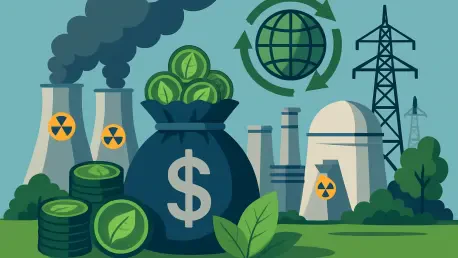Imagine a global system designed to slash carbon emissions, yet it overlooks one of the most powerful tools in the fight against climate change. Carbon markets, pivotal in incentivizing low-carbon solutions, continue to exclude nuclear energy—a source that prevents over 430 million metric tons of CO2 emissions annually, rivaling the output of a major economy like Japan. In 2025, as the world races toward net-zero goals, this omission stands as a glaring gap in market design, distorting economic signals and slowing decarbonization. This analysis explores the current state of carbon markets, the impact of sidelining nuclear power, and the trends shaping its potential integration. By dissecting data, policy barriers, and future projections, the aim is to uncover why recognizing nuclear energy is not just an option but a necessity for a robust and equitable climate strategy.
Diving into Market Dynamics: Trends and Gaps in Carbon Trading
Current Landscape: Exclusion as a Persistent Barrier
Carbon markets have evolved into essential mechanisms for pricing emissions, with voluntary standards like Verra and Gold Standard driving significant investment in renewables. However, nuclear energy remains conspicuously absent from these frameworks, barred from generating carbon credits despite its status as the second-largest source of low-carbon electricity globally. This exclusion stems from historical concerns over safety and proliferation, which, while valid in past decades, clash with the current scientific consensus from bodies like the Intergovernmental Panel on Climate Change (IPCC) that highlight nuclear’s role in limiting warming to 1.5°C. The result is a market that fails to reward a technology operating at over 90% capacity, providing stable baseload power where renewables often falter due to intermittency.
Economic Impacts: Distorted Incentives and Lost Opportunities
The financial implications of nuclear’s exclusion are profound, creating a skewed playing field within carbon markets. Without access to carbon finance, maintaining aging nuclear plants or funding innovative designs like small modular reactors (SMRs) becomes less viable, often leading utilities to pivot toward fossil fuels as a cheaper short-term fix. Data underscores this trend: regions that decommission nuclear facilities without market support, such as parts of Europe and North America, frequently see emissions spikes, with Germany’s coal resurgence after its nuclear phase-out serving as a stark example. Meanwhile, renewables like solar and wind reap market benefits, despite requiring backup systems that nuclear could efficiently provide. This imbalance stifles a critical decarbonization tool and risks delaying global emission reduction targets.
Global Disparities: Equity Challenges in Developing Regions
Beyond economics, carbon markets’ oversight of nuclear power exacerbates inequities, particularly for nations in the Global South. Many of these countries grapple with unreliable grids and limited space for sprawling renewable projects, making nuclear’s compact, consistent energy output an ideal solution. Yet, lacking market incentives, they often turn to coal—a high-emission but accessible alternative—undoing renewable gains as noted by the International Energy Agency (IEA). This dynamic not only hinders climate progress but also limits energy sovereignty, locking developing economies into fossil fuel dependency. Addressing this gap could redefine carbon markets as truly inclusive systems, supporting diverse energy needs across the globe.
Projections and Possibilities: Nuclear’s Emerging Role
Policy Shifts: Signs of Change on the Horizon
Looking ahead, there are promising signals that carbon markets may soon evolve to embrace nuclear energy. The European Union’s classification of nuclear as a green energy source within its taxonomy marks a pivotal shift, reflecting broader acceptance of its climate benefits. Projections from the IPCC and IEA suggest a need to double nuclear capacity by 2050 to meet warming limits, a target unattainable without financial mechanisms like carbon credits. If current voluntary market standards begin revising rules to include nuclear—with stringent safety and transparency protocols—the economic landscape could transform, unlocking capital for both existing plants and cutting-edge technologies over the next decade.
Innovation Potential: Beyond Traditional Nuclear Power
The future of nuclear in carbon markets also hinges on innovation, with emerging technologies poised to redefine its applications. Small modular reactors offer safer, scalable options for diverse settings, while advancements in molten salt systems and fusion prototypes promise efficiency gains. Beyond electricity, nuclear could decarbonize hard-to-abate sectors like steel and cement through hydrogen production and desalination processes. However, without market recognition, these innovations struggle to attract investment, lagging behind subsidized renewables. Integrating nuclear into carbon trading frameworks could accelerate these developments, positioning it as a cornerstone of a multifaceted energy transition.
Market Growth: Quantifying the Untapped Value
Analyzing potential market growth reveals the scale of opportunity lost by excluding nuclear. If integrated, nuclear projects could generate credits for avoiding hundreds of millions of metric tons of CO2 annually, creating a multi-billion-dollar segment within carbon markets. This influx would not only bolster existing capacity but also incentivize new builds, particularly in regions with rising energy demand. Forecasts indicate that aligning market rules with science-driven policies could enhance overall market credibility, attracting more corporate and governmental buy-in. The challenge lies in overcoming entrenched biases, but the reward—a more comprehensive and effective carbon market—remains within reach.
Reflecting on the Path Traveled: Strategic Steps Forward
Looking back on this analysis, the journey through carbon market dynamics reveals a critical flaw: the exclusion of nuclear energy undermines the very goals these markets aim to achieve. The data speaks clearly, with nuclear’s proven impact on emissions reduction clashing against outdated policy barriers, while economic distortions and global inequities highlight the urgency of reform. Real-world consequences, from emission surges to stifled innovation, paint a picture of missed potential. Moving forward, strategic action emerges as the logical next step—revising carbon market standards to include nuclear with rigorous oversight offers a tangible solution. Policymakers need to prioritize science over perception, while investors could champion advanced nuclear projects to bridge financial gaps. Ultimately, the push toward a complete carbon market demands collaboration across sectors, ensuring that every low-carbon tool finds its rightful place in the fight against climate change.









